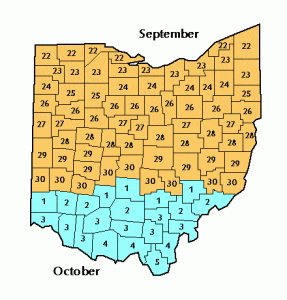Source: USDA
 Sustained Wet Conditions
Sustained Wet Conditions
Heavy rains last week saturated fields and prevented any large-scale planting activities, according to Ben Torrance, State Statistician, USDA NASS, Ohio Field Office. Topsoil moisture conditions were rated 31 percent adequate and 69 percent surplus. Statewide, the average temperature for the week ending on April 14 was 56.8 degrees, 9.4 degrees above normal. Weather stations recorded an average of 1.86 inches of precipitation, 0.98 inches above average. There were 0.7 days suitable for fieldwork during the week ending April 14.
Farmers reported that with the excess rain, the only field work that could be done was applying herbicide and fertilizing wheat. Oats were 11 percent planted. Winter wheat was 51 percent jointed and winter wheat condition was 70 percent good to excellent. Warmer than normal conditions continued to push fruit crop development.


 This year’s weather has been temperamental, with temperatures fluctuating wildly between above average to below average over the past few months, according to Ben Torrance, State Statistician, USDA NASS, Ohio Field Office. Topsoil moisture conditions were rated 32 percent adequate and 68 percent surplus. Statewide, the average temperature for the week ending on April 7 was 46.3 degrees, 0.3 degrees above normal. Weather stations recorded an average of 2.67 inches of precipitation, 1.8 inches above average. There were 0.3 days suitable for fieldwork during the week ending April 7. Precipitation last week left fields saturated and brought fieldwork to a stop. Drier weather settled in towards the end of the week, but most fields remained too wet to hold heavy equipment. Oats were 7 percent planted. Winter wheat was 16 percent jointed and winter wheat condition was 67 percent good to excellent. Fruit trees began blossoming in the northern counties after last week’s light frost.
This year’s weather has been temperamental, with temperatures fluctuating wildly between above average to below average over the past few months, according to Ben Torrance, State Statistician, USDA NASS, Ohio Field Office. Topsoil moisture conditions were rated 32 percent adequate and 68 percent surplus. Statewide, the average temperature for the week ending on April 7 was 46.3 degrees, 0.3 degrees above normal. Weather stations recorded an average of 2.67 inches of precipitation, 1.8 inches above average. There were 0.3 days suitable for fieldwork during the week ending April 7. Precipitation last week left fields saturated and brought fieldwork to a stop. Drier weather settled in towards the end of the week, but most fields remained too wet to hold heavy equipment. Oats were 7 percent planted. Winter wheat was 16 percent jointed and winter wheat condition was 67 percent good to excellent. Fruit trees began blossoming in the northern counties after last week’s light frost.

 Year 2 of Battle for the Belt kicked-off with corn and soybean planting on March 25 at the Western Agricultural Research Station in Clark County:
Year 2 of Battle for the Belt kicked-off with corn and soybean planting on March 25 at the Western Agricultural Research Station in Clark County: 



 Most of our first cutting is complete. If you have not mowed yet continue to monitor for alfalfa weevil. As regrowth starts begin to monitor for potato leafhopper.
Most of our first cutting is complete. If you have not mowed yet continue to monitor for alfalfa weevil. As regrowth starts begin to monitor for potato leafhopper. What a difference a week makes. Most of our corn is now planted and about 50% has emerged.
What a difference a week makes. Most of our corn is now planted and about 50% has emerged.
 Like corn, bean planting is coming to an end. Soil crusting is also an issue in many of our bean fields. Continue to scout these fields for emergence problems.
Like corn, bean planting is coming to an end. Soil crusting is also an issue in many of our bean fields. Continue to scout these fields for emergence problems. 





 Same story as corn. Early planted soybeans are beginning to emerge. As you evaluate your plant stand, do not be too concerned, yet – it is still early!
Same story as corn. Early planted soybeans are beginning to emerge. As you evaluate your plant stand, do not be too concerned, yet – it is still early!

